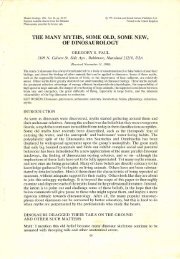HUNTERIA - Gregory S. Paul
HUNTERIA - Gregory S. Paul
HUNTERIA - Gregory S. Paul
You also want an ePaper? Increase the reach of your titles
YUMPU automatically turns print PDFs into web optimized ePapers that Google loves.
scapulocoracoid (Jensen 1985a, BYU 5001, Fig 4A, popularly<br />
labeled "Ultrasaurus"). It has the short, rounded amerior<br />
scapular process, short rounded coracoid, narrow scapular<br />
neck, and broad, rounded blade fully compatible with a<br />
brachiosaur. Jensen suggests that the scapula blade was not<br />
as broad as in Brachiosaurus, but some B. brancai blades<br />
are similar in breadth.<br />
The caudals, scapula, coracoid, humerus, ilium, and femur<br />
ofB. altithorax and B. brancai are very similar, and though<br />
the limb bones of the former are a bit more robust these<br />
elements could belong to the same species. It is in the dorsal<br />
column and trunk that the significant differences occur. To<br />
start with, at any given point, the dorsal column of<br />
B. altithorax is about 25-30% longer relative to the humerus<br />
or femur than that ofB. brancai (Fig. 2, Table 1).Riggs (1903)<br />
commented on the unusually long ribs of the Morrison<br />
sauropod, and indeed the longest dorsal rib is some 10% longer<br />
relative to the humerus than in B. brancai.<br />
The dorsals of both species are crushed, hampering comparison,<br />
especially quantitative. The posterior dorsals appear<br />
to be fairly similar. However, all the dorsal centra of<br />
B. altithorax have pleurocoels that are about 50% larger than<br />
those ofB. brancai (Fig. 3E-G). The neural arches are taller<br />
A<br />
BRACHIOSAUR GIANTS<br />
and longer in B. altithorax, but are much narrower. The<br />
transverse processes form a shallow V in B. brancai; in<br />
B. altithorax they appear to be flatter.<br />
The anterior and mid dorsals differ the most. In B. brancai,<br />
dorsal 4 is very gracile, with very long, proximally deep, distally<br />
tapering transverse processes and a tall, slender neural spine.<br />
The centrum is rather small and short. Excepting the centrum,<br />
dorsal 4 differsgreatly from the posterior dorsals in being much<br />
taller and wider. In the upper portions, the anterior dorsals<br />
ofB. altithorax differ relatively little from the more posterior<br />
vertebrae - their neural spines and transverse processes are<br />
only a little longer. Compared to the posterior arches, the<br />
anterior arches are longer both vertically and fore and aft.<br />
Very notable is the length of the anterior dorsal centra<br />
relative to those of the posterior dorsals in B. altithorax.<br />
Incomplete columns, crushing, centra fusion, and incomplete<br />
measurements hamper quantitative comparisons. But in<br />
HMN SII and BMNH M 26, the anterior dorsals are about<br />
the same length as the posterior dorsals. In FMNH P25107<br />
the mid dorsal centra are about 50% longer than those of the<br />
posterior dorsals (Fig. 2). Such elongation of mid-anterior<br />
dorsals is most unusual for sauropods and dinosaurs - even<br />
in Diplodocus and Barosaurus only the first two dorsals<br />
F G<br />
Figure 3-Anterior dorsals in left lateral (top) and posterior (bottom) views, drawn to the same zygapophysis-to-bottom-of-centrum height. Dorsal 5 in<br />
A) Apatosaurus louisae CM 3018; B) Diplodocus carnegii CM 84; C) Camarasaurus grandis YPM 1901 or 1902; and D) Camarasaurus suprernus<br />
AMNH 5761. Anterior dorsal in E) B. (Brachiosaurus) altithorax referred BYU 5000; dorsal 6 in F) B. (B.) altithorax holotype FMNH P25107; and<br />
dorsal 4 in G) Brachiosaurus (Giraffatitan) brancai holotype HMN SI!. Data from Gilmore, 1937; Hatcher, 1901;Janensch, 1950a; Jensen, 1985a: Osborn<br />
and Mook, 1921; Ostrom and Mclntosh, 1966: Riggs, 1903.<br />
<strong>HUNTERIA</strong> VOL. II, no. 3, pp. 7, February 19, 1988









